With the amount of freight (5 tonnes) Australia transports daily, it is no doubt that the transport sector is critical to the economy of Australia.
Through this blog, you will learn 20+ statistics about the Australian transportation sector that will blow your mind about this industry
Top Essential Australian Transport Statistics to Know and Remember
- The flight sector declined by 63% the number of passengers due to COVID-19 in 2021
- The transport sector hit the $105 billion mark in 2021
- The total GVA earned by both the transport and postal divisions grew by 4,0% in 2022
- Households increased their spending by 64% in the 1st quarter of 2022
- In 2021, the total amount contributed by the transport industry was over $230 billion
- 70% of cars travelling in Australia carry passengers.
- Over 30% of Aussies in the transportation industry all drive trucks
- The Australian railway transport industry has an average annual income of over $20 billion.
- In Australia, the most highly valued exports and imports are transported by marine.
The Metrics of the Transport Industry in Australia
1. How Large Is This Industry?
The industry is worth millions of dollars. In 2021 alone, the sector dropped in total revenue by more than 0.7%(about $229), while the IVA dropped by 4.5%, translating to $3.5 billion.
Although, when the government reopened the borders and allowed citizens to travel internationally in 2022, the sector improved, increasing the GVA by 4.8 and contributing to about 0.2 of Australia’s GDP growth.
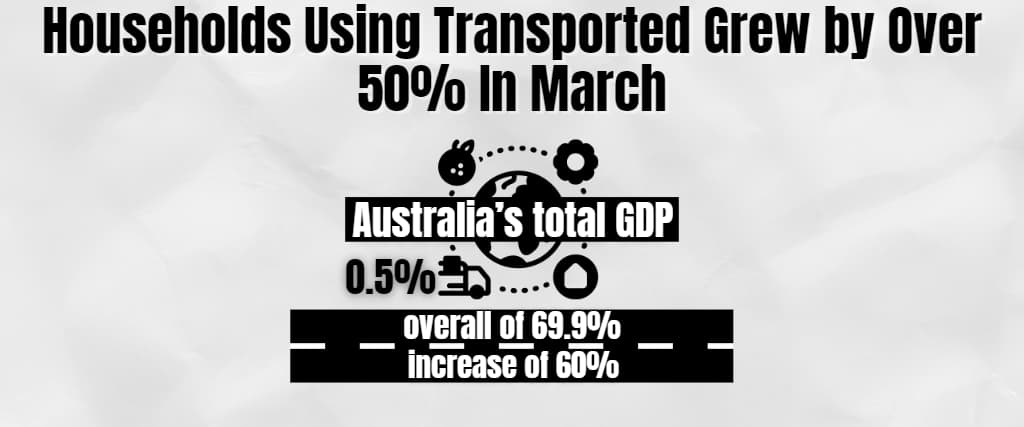
2. Households Using Transported Grew by Over 50% In March
Most households increased how much they spend on transport, which resulted in a revenue increase of 60% by March of 2022 and an overall of 69.9%, contributing about 0.5% of Australia’s total GDP.
3. Number of Women CEOs Representing 4.6% of Total CEOs
Unlike in the previous years, where women stayed away from the industry, in 2021, there was an increase of 3.1% in the women who participated in the task force- soon, the transport industry will be among the female-dominated sectors.
Australian Road Freight Statistics
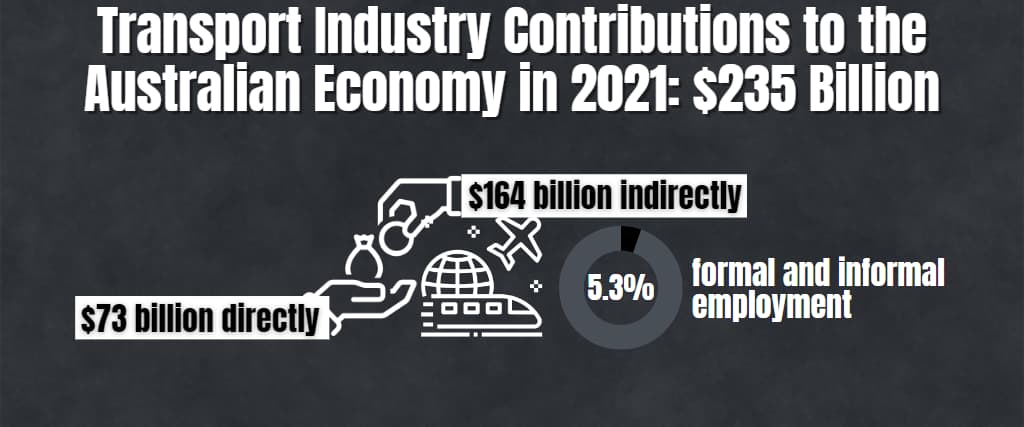
4. Transport Industry Contributions to the Australian Economy in 2021: $235 Billion
The industry has one of the most significant impacts on the Australian economy; in 2021, the sector contributed over $73 billion directly and $164 billion indirectly. Additionally, it has accounted for over 556,000(5.3%) people in formal and informal employment.
5. Total Road Transport Volume for 2020-2021: 230 Billion Tonne-Kilometers
research shows that In 2021, common commercial vehicles and rigid trucks transported 9.2 and 43.5 billion tonne-kilometres, respectively, while articulated trucks totalled 177.7 billion tonne-kilometres. In 2020, bulk freight contributed to 83.1 billion tonnes- km, which will likely keep increasing.
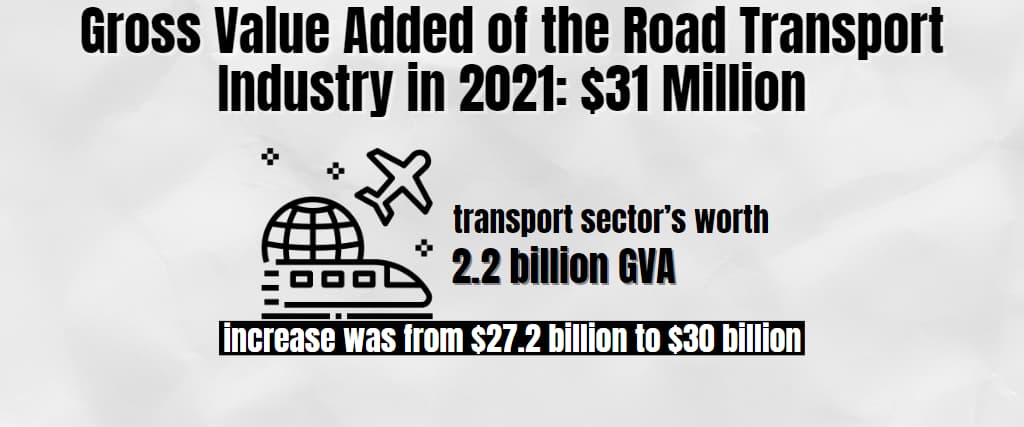
6. Gross Value Added of the Road Transport Industry in 2021: $31 Million
Between 2020 and 2021, the transport sector’s worth increased significantly by 2.2 billion GVA — the increase was from $27.2 billion to $30 billion, which is one of the most outstanding increases the sector has had,
7. 80% of Cars in Australia Carried Passengers in 2020
In 2020, 80% of the total vehicles in Australia were carrying people, which amounted to 15,700,800 cars, contributing to about 24.2% (14.9 million) of the Australian car market, preceded mainly by SUVs
Freight vehicles were second in line, making up about 20.9% out of the vehicles that travelled by road, leaving 0.4% to the trucks
8. Intrastate Luggage Travel Accounts for 70% of Total Kilometers Driven in Australia
According to ABS, 96% of the weight carried by Australian vehicles was instated, leaving 4% to the freight movements that travelled through other states.
However, from the total distance covered, instate travel contributed 31% of the kilometres, leaving 69% of the space to travel out of the Australian state.

9. An Anticipated 205k+ Employees in the Overall Road Luggage Transport Industry By 2025
Out of the entire postal, transport, and warehousing sector in 2021, freight transport by road accounted for the greatest employment, about 187,300. The rest were as follows:
- Passenger transport by road employed 85,600
- General marine contributed 13,500 to the total employment
- Storage and warehousing contributed to 78,600 of the full employment
- Postal delivery and pick-up services employed 132,300 people
- The remaining transport operations used a total of 35,100.
Australian Transport and Logistics Statistics
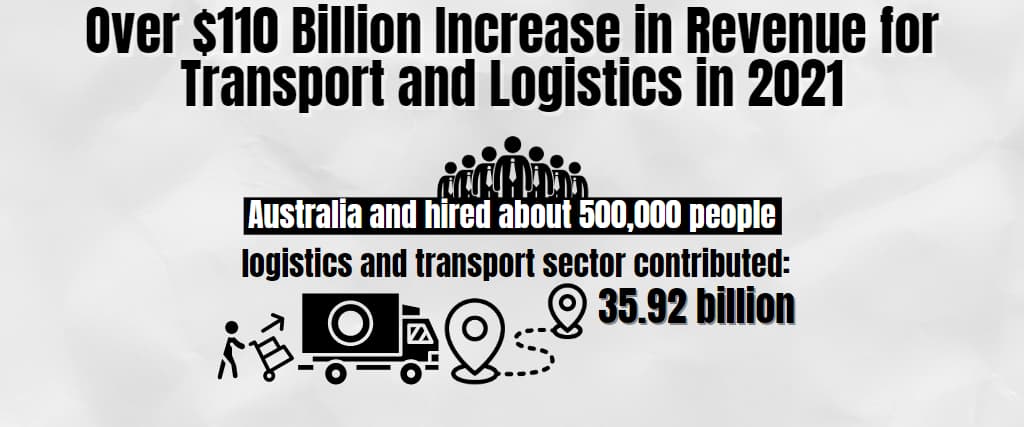
10. Over $110 Billion Increase in Revenue for Transport and Logistics in 2021
In 2020, the logistics and transport sector contributed more than 35.92 billion to Australia and hired about 500,000 people to work in the industry. In 2021, the industry took a notch higher, recording an outstanding revenue of $101.91 billion.
11. An Anticipated $114.32 Projection for Australia’s Freight and Logistics Market
Australians should expect an economic value growth of more than $20 billion between 2021-2017 in the freight and logistics sector. Additionally, Australia should expect to grow by 5.85% in CAGR.
12. 33.2% of Workers in the Transport and Logistics Industry
Among the various trends within the industry, the major one is that driving trucks has become the most famous occupation in the transport and industry sector.
Next is coach and bus driving, which is about 14% of car drivers (12%) are the second most popular in the transport industry, finalised by delivery people(2.3%).
Fun fact: Delivery drivers make about $28,800 annually without prior experience as a qualification. Deliveroo Menulog, UberEats, and DoorDash drivers are the highest-paid drivers in Australia.

13. Over 50,000 Participants Signed Up for Transport and Logistics Program in 2021
Despite its impact on the economy, statistics show that the total number of people signing up for the logistics and transport program in 2019 has significantly decreased compared to 2016
In 2016, enrolments hiked to 73,532, with 19,986 completing the programs. In 2018 the enrolment significantly dropped by 23,532, followed by another drop of 37,652 in 2019, to a point where Australia ended up with 9,500 through 2020.
Here is a list of where the enrolments originated from:
- South Wales
- Queensland
- South Australia
- Western Australia,
- Tasmania
- Tasmania
- Victoria,
- Capital of Australia
- 0.7% were international students.
Warehousing and Postal Services Data Stats
14. $9.2 Billion Market Valuation of the Australian Postal Services
In 2022, the postal services sector grew by roughly 3.8%, from $8.7 billion to $9.5 billion. Additionally, between 2017-2022 the growth fueled an annual increase of 1.7%, mostly from online services and shopping.
15. Productivity Index for Transport, Postal, and Warehousing Sectors at 93.84 in 2021
The productivity index in Australia’s warehousing, transport, and postal industry has recently dropped significantly from 107.5 to 93 in less than four years, similar to 2019 and 2020, then the productivity from 102.5 to 100.
16. 75.602 People Employed by the Australian Warehousing and Postal Industry
Regarding employment, the postal, transport, and postal sectors have been relatively shaky since 2020. After the industry reached its highest point in 2019 (100,000), the numbers dropped until they earned their most minimal point(56,003) in 2020. Afterwards, the employment rate rose to 86,000 in 2021 before falling back to 76,000 in early 2022.
17. $22.79 Billion Annual Revenue for the Rail Freight Industry
The railway sector has gained momentum in the past few years by breaking its records significantly, contributing to the economy. In 2020, the industry outdid the $20 mark, a huge contribution to the economy and an improvement of $8.55 billion. Additionally, the sector brags 961 businesses in Australia, of all divisions— passenger, operators, freight, etc
18. 10,000 People Offered Jobs By Reil Freight in 2020
The rail has had a consistent hire rate within the last ten years. Although, in 2020, the rail freight sector experienced a noticeable drop by half(5500), unlike the previous years.
The passenger sector has had an outstanding increment of employment rates of up to 10,000( from 11,700 to 20,900) between 2020 and 2021.
19. An Anticipated $515 Billion for Rail Freight By 2040
Australia should expect a volume rise of 16.4% in the rail freight division and an annual increase of up to 0.7% due to coal, ore, iron mining, and later exportation.
20. $27 Billion in Revenue for the Australian Aviation Sector
The aviation division is the most significant contributor to Australia’s economy ($ 27.94 billion), contributing about $10.50 billion annually. The air transport industry has donated over $40,000 in employment, while general transport operations were 15,300 in 2020.

21. $10.1 Billion Market Size for Australia’s Freight Industry
The air freight sector has grown furiously in the past five years, exceeding an annual growth of 15%. In 2022, the industry surpassed the $10 billion mark in economic value, increasing by 9.5% in 2022.
22. 41k More Air and Space Jobs in 2021
The space and air industry reached its optimum point in 2017, with more than 60,000 employees before dropping to 35,000 in early 2020.
However, economists predict the employment percentage will remain constant from 2021(40,000) to 2025(43,000).
While the space sector improves, airport operations are expected to drop in the number of employees by 2300 between 2020 and 2025 (from $15,300 to $13000).
23. A 63% Fall Off In International Flights During the Covid-19
Like all other sectors, COVID pulled back the transport sector and caused significant economic dents that might take a long time to recover. The industry faced a drop of about 50% in local travel and a 63% drop in international flights, as about 19.8 million passengers travelled in 2021.
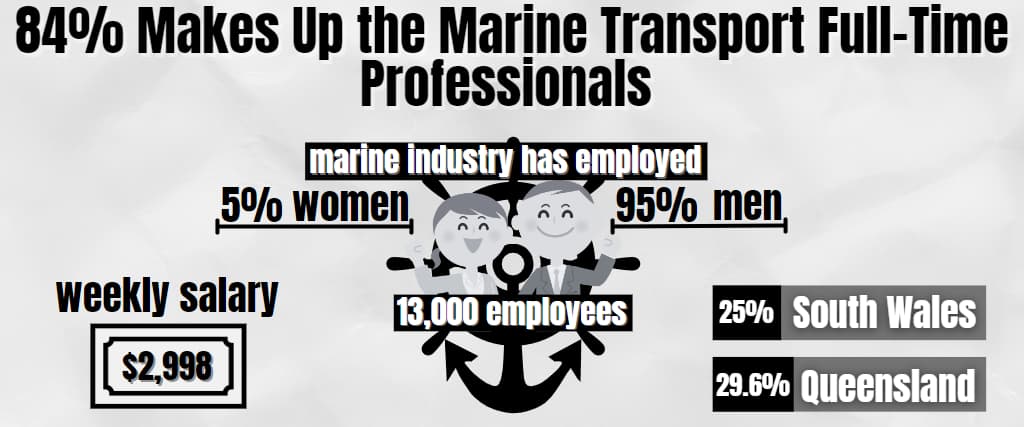
24. 84% Makes Up the Marine Transport Full-Time Professionals
The marine industry has employed various categories of employees, mostly men, taking up 95% of the entire task force, and women 5% of the employees.
Of all the 13,000 employees, 65% are full-time workers, with a weekly salary of $2,998.
Additionally, South Wales (25%) and Queensland (29.6%) contribute the most to most of the employees in the sector.
25. Marine Carries 24.80% High-value Import and Exports
With 80% of Australia’s imports and exports by sea, the marine industry has become rather popular, making Australia one of the top 5 users of Marine shipping worldwide.
Additionally, the country is the greatest user of cruise passengers with a sealine of about 60,000 kilometres — two in 34 Australians have travelled by sea.
Conclusion
The Australian transport division has already established its industry in Australia.
With the new trends in technology, it’s expected to keep extending, with the hope that it will narrow down the current gender and age gaps.
We hope most of your questions regarding Australia’s transport industry have been answered from the blog above.
FAQs
1. What is the most expansive sector of transportation?
The largest sector is road transportation, taking up about 45% of the entire transportation workforce with more than 150,000 workers. The industry is expected to keep growing to accommodate about 250,000 employees after five years.
2. What is the economic impact of transportation on Australia’s economy?
The transport industry is responsible for 0.5% of GDP growth as of the end of 2021.
3. How much competition does the freight industry in Australia face?
Freight companies in Australia add up to 57,650, with over 149,733 employees.